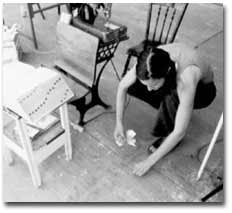
Stitched Poems -- Collage Sequence by Jen Bervin
 BIO:
Jen Bervin is the author of multiple artist's books, and, forthcoming,
under what is not under (Potes&Poets). Her work appears in
the journal, Chain, and the anthology POG ONE (Chax Press).
Bervin's art has been shown in the US, Canada, and China; her artist's
books are collected by the Walker Art Center Library. She works as a fire
look-out in southeastern Arizona.
BIO:
Jen Bervin is the author of multiple artist's books, and, forthcoming,
under what is not under (Potes&Poets). Her work appears in
the journal, Chain, and the anthology POG ONE (Chax Press).
Bervin's art has been shown in the US, Canada, and China; her artist's
books are collected by the Walker Art Center Library. She works as a fire
look-out in southeastern Arizona.
ACTS OF
RETRIEVAL:
Jen Bervin's recombinant poems
by
Cole Swensen
Jen Bervin's work is an act of retrieval; it's a gesture that recognizes all that is already here in the remnants that surround us. It's an art of recombination, and she makes no effort to hide the seams. The stitches that hold the fragments together become part of the visual pleasure, and the juxtapositions, intersections, overlaps and reiterations that join her fragments of language become an integral part of what we hear.
Bervin's works are made of remnants in a literal way as well. The thread she's been using for the past couple of years is a discontinued color found at a salvage shop; some of her paper is registration trim from a print shop, while other pieces are scraps given to her by her studio partner, Alison Kaplan, a bookmaker.
Bervin has referred to her process as "making a whole and then opening it back up again," and as "making a whole with pieces missing." The missing, the gaps, the lesions are, she says, where something has happened, and that happening is more important than the object itself, for it is the ongoing element, the outward motion. And it's only by moving outward that the text can reopen itself.
In this particular instance, it has opened into a new medium—the Internet. Given the importance of materials in her works, this radically new context must make a difference. Bervin has said, in fact, that the difference is entirely positive, noting that the web offers the best quality reproduction she's seen so far, picking up much of the original texture and detail.
But does the work get transformed, as it must, in order to be successful in such a radical translation? Again, she says yes; having worked extensively in video, Bervin welcomes the addition of ambient luminosity, recognizing it as an added dimension.
(this issue's table of contents)










